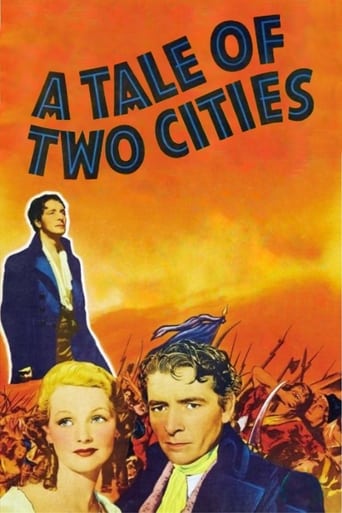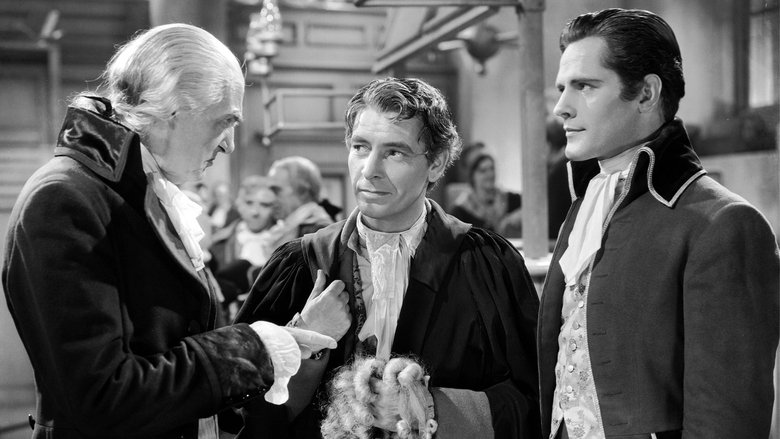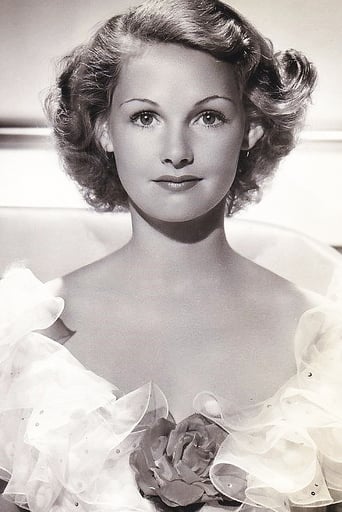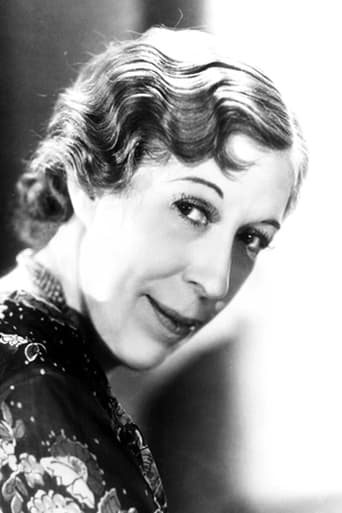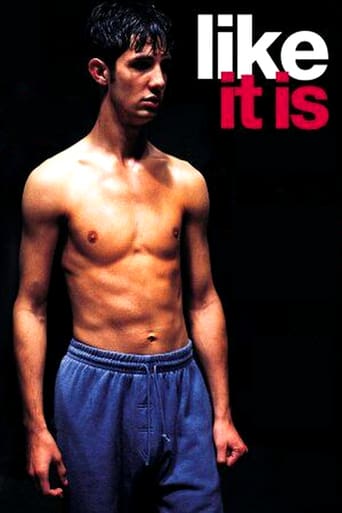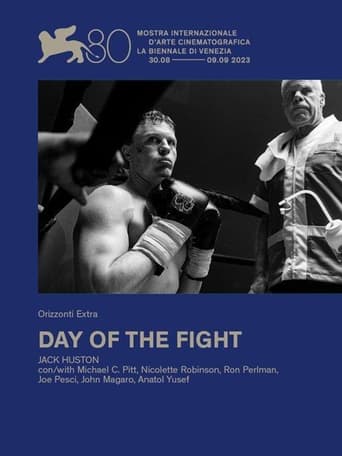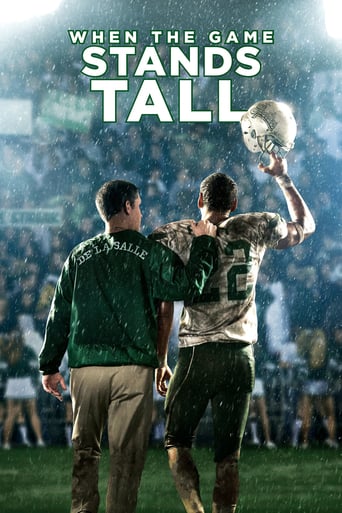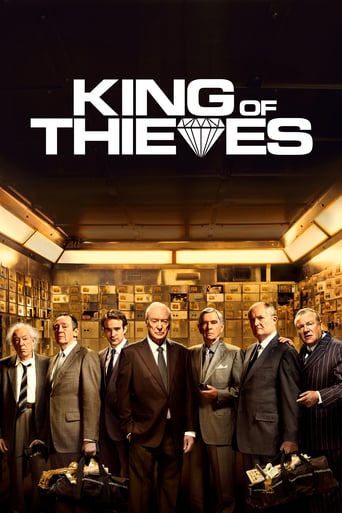A Tale of Two Cities (1935)
The exciting story of Dr. Manette, who escapes the horrors of the infamous Bastille prison in Paris. The action switches between London and Paris on the eve of the revolution where we witness 'the best of times and the worst of times' - love, hope, the uncaring French Aristocrats and the terror of a revolutionary citizen's army intent on exacting revenge.
Watch Trailer
Cast


Similar titles
Reviews
Good story, Not enough for a whole film
Good concept, poorly executed.
Wow! What a bizarre film! Unfortunately the few funny moments there were were quite overshadowed by it's completely weird and random vibe throughout.
The movie really just wants to entertain people.
Jack Conway's "A Tale of Two Cities" is based on the popular Charles Dickens novel of the same name depicting the events of the French Revolution and happens to depict them very well, and thanks to how Conway directed this movie it is also one of the finest period pieces that I've ever seen. The movie stars Ronald Colman in a role he always felt that he was born to portray as Sydney Carton an alcoholic British lawyer who defends a young Frenchman named Charles Darnay (Donald Woods) who happens to be a relative to an aristocrat named Marquis St. Evremonde (Basil Rathbone) who he differs from in every way in terms of political philosophy, and all the poor French citizens who are victims of the reign of King Louis XVI and his wife Marie Antoinette, and as punishment they wanted to kill all of the aristocrats as well as all of their relatives all the way down to babies which is a very sickening idea thanks to clouded judgment. Carton is also defending him for the sake of his wife (Elizabeth Allan), daughter,her maid (Edna May Oliver) and the rest of her family of which he credits for sobering him up, and as a result he decides to sacrifice himself for the sake of his friends which is his plan for getting Darnay out of prison. Although Colman felt he was born to play the role of Sydney Carton he strongly refused to play the dual roles of Carton and Darnay which are supposed to be lookalikes in the story. Though I didn't read the novel I do know that the novel starts with the words "It was the best of times, it was the worst of times." which I couldn't think of any better words that Dickens wrote to best describe this story. The screenplay along with Conway's sure handed direction makes you relate to both the British and the French citizens but the problem with the French people is that they let their emotions get the best of themselves and they totally acted out of revenge towards aristocrats and racism towards British people. The performances are very good but Colman is so good in this role that he makes the role of Carton his own and was unfortunately snubbed for a best actor Oscar nomination probably due to the fact that his performance was far too good for the Academy, this is a great film that is hardly remembered anymore, and is one of the finest films that the year 1935 had to offer.
I was first introduced to Charles Dickens' Tale of Two Cities in an 8th grade English class. When reading it was assigned I skimmed through the text without so much as a thought to the story. Later, when advised a test was to include questions on the story, I immersed myself into it and found myself enraptured with the story, the characters, the redemption and sacrifice of Sydney Carton for those he grew to love.Growing up in the 50's and early 60's, one was without knowing it at the time, gifted to watch multiple TV showings of now classic movies from the 30's, 40's and early 50's every afternoon.Maybe because I was discovering the opposite sex but I so identified, at fifteen, with Sydney Carton and his unrequited love for one he could not have, and his ultimate sacrifice for Lucie as a way of winning a place in her heart forever.I watched Sydney's apathy with life and his resignation to never fulfilling goals he had probably felt so close to his grasp at an earlier time. Ronald Coleman's performance was one I have felt since with each viewing.I have a niece that at 15, began providing her DVD's of the classics. The first was a Tale of Two Cities and even now, at 21 with a child of her own, she always jokingly tells me that she hates me for enlightening her with that movie as she has always felt that Sydney should not have switched places, no matter how noble the reason because she felt he and Lucie should have ended up together.Even though I always point out the improbability of that and of the deeper notions of true love and the nobility of the ultimate sacrifice when called for, she remains unchanged and I smile because I know the everlasting impression that the story will remain with her forever.I just gifted her with a beautifully printed, gold leafed edition of the book and instructed her to read it to her daughter when old enough, so she can also pass on a classic beautiful story by Charles Dickens and the Ronald Coleman film as well.Unfortunately, I never had children of my own but know I have passed on to this beautiful, intelligent young woman a gift of classic appreciation.
MGM's Ronald Colman version of Charles Dickens' "A Tale of Two Cities" has more in common with the best of films, and less in common with the worst of films. Producer David O. Selznick guaranteed it a nice budget, which results in a some finely-edited incidental scenes. Every so often, you are startled by how well something is done - but, generally, the story goes through the motions. It is nice to see Mr. Colman perform the "Sydney Carton" role. The other leads do not work well with him, however. Colman's "Carton" is supposed to be identical in appearance to the "Charles Darnay" character played by Donald Woods. The two men are vaguely similar types, but Mr. Woods is a bigger, taller man; and, his youth makes Colman look a little old for the part. Elizabeth Allan (as Lucie) is pretty; she looks good with Woods, but has no little chemistry with Colman.The film offered a grand supporting cast - all eligible for the first "Best Supporting" Oscar given, but none were nominated.The best supporting actor almost looks to be Basil Rathbone, with his cruel depiction of French aristocracy; but, he doesn't appear much, and Mr. Rathbone could perform the part in his sleep. By the time he loses his tenuous sanity, fatherly Henry B. Walthall (as Alexandre Manette) really takes supporting actor honors; and, this was the last great character role for Mr. Walthall. For feminine honors, it's a battle between Edna May Oliver's wise-cracking English maid and Blanche Yurka's violently-knitting French peasant. They even have a supporting actress dogfight. Many admire Ms. Yurka's efforts, which are considerable; she chews the scenery and spits it out. Finally, by the time "The End" has come, it's very apparent this "Tale of Two Cities" has become a "Christmas Carol" - of course, as in the original work, Dickens would prefer the comparison to be more allegorical.******* A Tale of Two Cities (12/25/35) Jack Conway ~ Ronald Colman, Donald Woods, Henry B. Walthall, Blanche Yurka
The story line may not seem to be your usual cup O' tea, but I was impressed. It's the way Dickens would probably have wanted it made for the screen, and TV. It is as if someone went back in time with a hidden camera to bring us what it might have been like had we too lived in that era, under the changing social mores and attitudes.You'll probably recognize some of the character actors, as well as how their lines are delivered - truly realistic, and professional. No talent goes unused - from street urchin to the aristocrat - all do a great job.You will enjoy A Tale of Two Cities because even without colour, the techniques and skills put behind the camera, direction and lighting, plus background music create what colour can never do - an artistic, enticing, and most entertaining movie.

